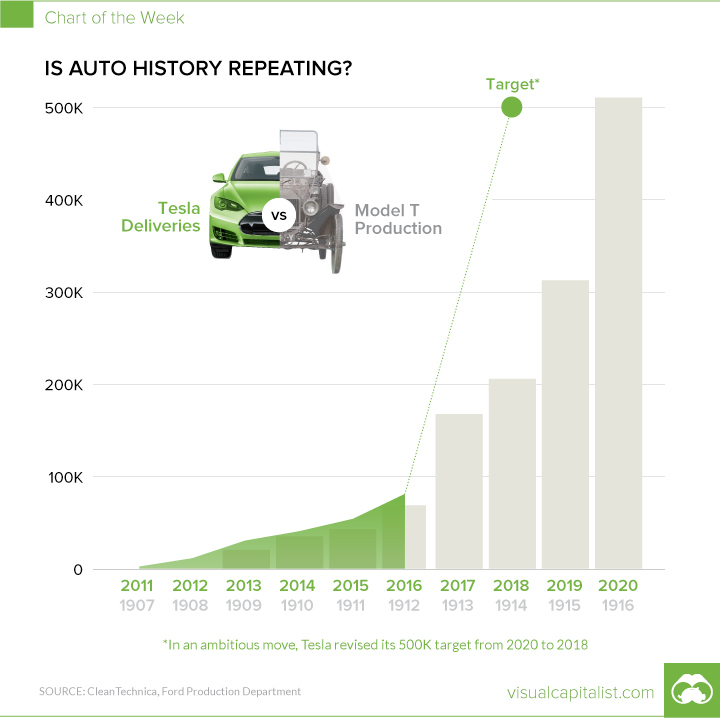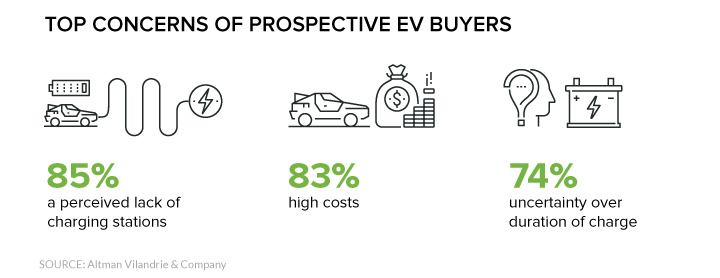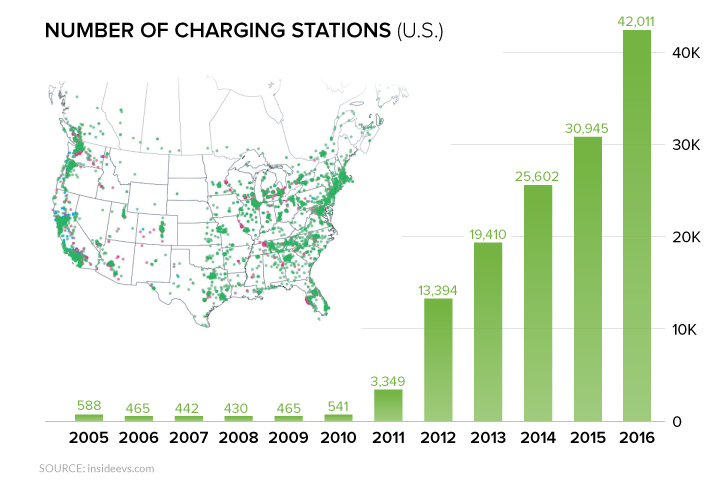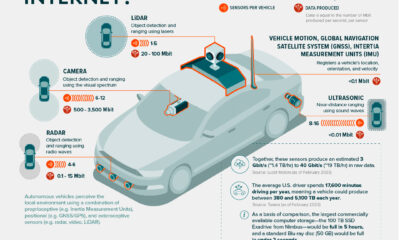When automobiles first debuted in the United States, they faced a classic “chicken and egg” problem. On one hand, autos were custom-made luxury items, affordable only to a niche market of affluent individuals. On the other hand, there was little incentive for most people to buy automobiles in the first place, as the system of roads in America was woefully underdeveloped. Henry Ford managed to solve the “chicken and egg” problem with the Model T, the first product of its kind to reach the mass market. But today, there’s also another auto industry visionary facing a similar challenge in the 21st century: Elon Musk and his company, Tesla.
Similar Tracks
Ford’s assembly line and uncomplicated design allowed for cheaper pricing, which helped Ford sales to take off. With many new Model Ts hitting the road, the United States government was able to generate enough revenue from gasoline taxes to enable the sustainable development of roads in the United States. More roads meant a renewed desire for more Model Ts to populate those roads, and so on. This was the start of a trend that sees 253 million cars on American roads a century later.
Cost and Infrastructure: Dueling Priorities
Fast-forward to today, and vehicle buyers have concerns not unlike those of early automobile adopters at the turn of the 20th century. Aside from the price of purchasing a new vehicle, most prospective buyers of electric vehicles cite charging availability and maximum travelling range as their biggest challenges.
Fortunately, EV prices are already falling due to advancements in the production of one of their key components: the lithium-ion battery packs that power them. At one point, battery packs made up one-third of the costs for a new vehicle, but battery costs have dropped precipitously since 2010. That said, automakers like Tesla will need to continue to make progress here if they hope to match the growth and saturation of their forebears at the turn of the 20th century.
Charging Ahead of Demand
A study by the National Science Foundation’s INSPIRE Project found that the current amount of money disbursed as tax credits to new electric vehicle buyers (currently up to $7,500 per vehicle) would have been sufficient to build 60,000 new charging points nationwide. The growth of charging station infrastructure is already astonishing. New public outlets have been added at a 65.3% CAGR between 2011 and 2016, and further growth will open even more roads to long-distance EV travel and network effects. According to the math of the study, new charge stations would have a bigger effect on the EV market than the tax credits, and could have increased EV sales by five times the amount.
In short, charging stations will be to Tesla what roads were to Ford: the means by which they can reach lofty new heights of market dominance. Infrastructure development may be the “push” that electric vehicles need to get them over the early adoption barrier and into the mainstream. Combined with falling costs and improved efficiency, electric vehicles could create a Ford-like transformation within the automotive industry in a very short time. on Over recent decades, farmers have been able to more than double their production of crops thanks to fertilizers and the vital nutrients they contain. When crops are harvested, the essential nutrients are taken away with them to the dining table, resulting in the depletion of these nutrients in the soil. To replenish these nutrients, fertilizers are needed, and the cycle continues. The above infographic by Brazil Potash shows the role that each macronutrient plays in growing healthy, high-yielding crops.
Food for Growth
Nitrogen, phosphorus, and potassium (NPK) are three primary macronutrients that are the building blocks of the global fertilizer industry. Each plays a key role in plant nutrition and promoting crop growth with higher yields. Let’s take a look at how each macronutrient affects plant growth. If crops lack NPK macronutrients, they become vulnerable to various stresses caused by weather conditions, pests, and diseases. Therefore, it is crucial to maintain a balance of all three macronutrients for the production of healthy, high-yielding crops.
The Importance of Fertilizers
Humans identified the importance of using fertilizers, such as manure, to nourish crops dating back to nearly 6,000 to 2,400 BC. As agriculture became more intensive and large-scale, farmers began to experiment with different types of fertilizers. Today advanced chemical fertilizers are used across the globe to enhance global crop production. There are a myriad of factors that affect soil type, and so the farmable land must have a healthy balance of all three macronutrients to support high-yielding, healthy crops. Consequently, arable land around the world varies in the amount and type of fertilizer it needs. Fertilizers play an integral role in strengthening food security, and a supply of locally available fertilizer is needed in supporting global food systems in an ever-growing world. Brazil is one of the largest exporters of agricultural goods in the world. However, the country is vulnerable as it relies on importing more than 95% of its potash to support crop growth. Brazil Potash is developing a new potash project in Brazil to ensure a stable domestic source of this nutrient-rich fertilizer critical for global food security. Click here to learn more about fertilizer and food production in Brazil.



































